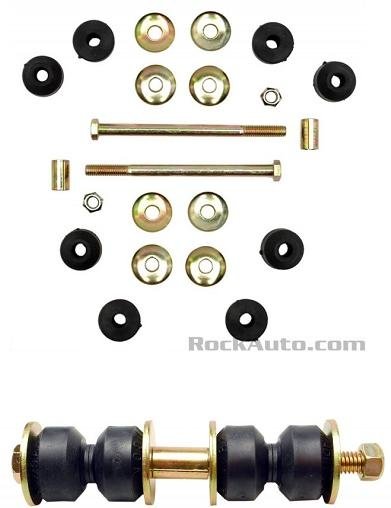Part numbers for things like this are irrelevant except to the person who has to order the parts for you. If you visit any auto parts store, they will look up what you need by application. In this case, the links are of the most common design that has been around since the '60s. The repair kit will cover some car models from almost every manufacturer.
The kit is shown in the photo. Enough parts are shown for two links. They usually come this way because both links wear at the same rate, only one broke first, and the other one is sure to fail soon if it is not replaced at the same time. One assembled link is shown at the bottom of the photo. These are real easy to install on most cars. The frustrating part can be removing the old ones. Mechanics will use air-powered cutoff tools to cut the rusty nuts off. Often the bolt heads have to be cut off too because the metal sleeve that must be slid off is usually rusted tight.
Typically what happens is the rubber isolators deteriorate and crack off, then the metal washers clink around like on a tambourine. The classic noise is a high-pitched metallic rattle, heard mostly over bumps, and much more easily when the sound reflects off a nearby building you're driving past.
I can offer a couple of pieces of wisdom related to these. The first mistake to avoid is not replacing the second link right away. That old one won't have any stress on it when the first one is broken or sloppy, so it is not going to fail. Don't think you can wait for the second one to fail, then you'll replace both at the same time. Once the broken one is replaced, the other one will resume its job and will fail in short order. The piece of wondrous advice is to remove both links, then assemble both new ones before doing the final tightening. Sorry that I made that sound more complicated than it really is. If you assemble one link first, and tighten the nut, that holds the anti-sway bar in the correct position, and that makes it real hard to force the parts into place on the other side. Instead, assemble the first link but leave the nut loose. Assemble the second link, then tighten both nuts.
As a point of interest, on most applications there is no right or wrong way to orient the bolts. The bolts can be dropped down from on top or the heads can end up on the bottom. Watch for clearance so the threaded ends can't catch on something, but basically the links are installed on the assembly line the way that's most convenient or fastest.
My second great and wondrous warning is the nuts can be over-tightened, and that must be avoided to prevent premature failure. These rubber isolators are designed to expand as they become squished between the washers. You've reached the proper tightness when those rubber isolators expand to exactly the same diameter as the washers. If they are expanded fatter than the washers, just back the nut off as necessary; no harm done. Some do-it-yourselfers run the nuts down as far as possible until they run out of threads. That can result in elusive rubbing noises from the bar rubbing on the washers. The isolators will split apart within a few months from that severe over-tightening.
The nuts are usually lock nuts so they won't work loose on their own. I like to coat the bolts with anti-seize compound or Spray White Grease to keep the sleeves from rusting to the bolts. My thinking is they'll be easier to remove next time.
A visual inspection will show if it's really the links that are noisy. If they look okay, have the steering and suspension systems inspected at a tire and alignment shop. The people there are experts at finding the causes of noises, vibrations, and bad tire wear. If you're hearing more of a dull thud or single clunk, that is not likely to be caused by the anti-sway bar bushings or links. Ball joints, control arm bushings, and struts are better suspects for that.
Here's a link to a related article that might give you more ideas of things to look for:
https://www.2carpros.com/articles/popping-noise
They show your anti-sway bar link too, but a longer version of it from a different car model.
Image (Click to make bigger)
Friday, March 15th, 2019 AT 6:16 PM



